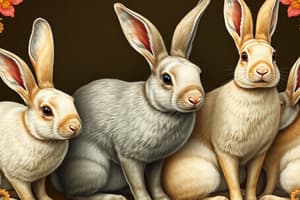Podcast
Questions and Answers
What factors should be considered when deciding where to locate a rabbit enterprise?
What factors should be considered when deciding where to locate a rabbit enterprise?
Availability of water and land, climatic conditions, and availability of extension services.
Why is regular cleaning and disinfecting of rabbit housing important?
Why is regular cleaning and disinfecting of rabbit housing important?
Prevents the build-up of pathogens, reduces the risk of disease outbreaks, and promotes a healthy environment for the rabbits.
Why is it important to separate rabbits according to gender, age, and breed type in a rabbit enterprise?
Why is it important to separate rabbits according to gender, age, and breed type in a rabbit enterprise?
Prevents unwanted breeding, reduces aggression, and simplifies management practices by grouping rabbits with similar needs.
Explain why potato and tomato leaves should not be fed to rabbits.
Explain why potato and tomato leaves should not be fed to rabbits.
Detail how the regular watering of rabbits helps to maintain their health.
Detail how the regular watering of rabbits helps to maintain their health.
Describe proper handling techniques to minimize stress and the risk of injury to rabbits.
Describe proper handling techniques to minimize stress and the risk of injury to rabbits.
Describe the process of sexing a rabbit.
Describe the process of sexing a rabbit.
Describe the key steps to taking care of a rabbit after it has given birth.
Describe the key steps to taking care of a rabbit after it has given birth.
What are some of the key symptoms of Coccidiosis in rabbits?
What are some of the key symptoms of Coccidiosis in rabbits?
What steps are involved in processing a rabbit for meat?
What steps are involved in processing a rabbit for meat?
Flashcards
Rabbit Breeds
Rabbit Breeds
New Zealand Red, New Zealand White, Chinchilla, Californian white, and Flemish giant.
Starting Factors
Starting Factors
Demand and supply, labor, water/land, capital, climate, extension services, feeds, and medical supplies.
Pre-Arrival Steps
Pre-Arrival Steps
Clean and disinfect housing, buy vaccines/drugs/feeds, clean feeders/drinkers, and hire/train labor.
Housing Significance
Housing Significance
Signup and view all the flashcards
Roughage Feeds
Roughage Feeds
Signup and view all the flashcards
Root Crop Feeds
Root Crop Feeds
Signup and view all the flashcards
Concentrate Feeds
Concentrate Feeds
Signup and view all the flashcards
Watering Reasons:
Watering Reasons:
Signup and view all the flashcards
Handling Methods
Handling Methods
Signup and view all the flashcards
Handling Precautions
Handling Precautions
Signup and view all the flashcards
Study Notes
- The document provides information on rabbit production, including breeds, starting an enterprise, preparations for arrival, housing significance, budgeting, feeding, handling, health, and processing.
Rabbit Breeds:
- New Zealand Red
- New Zealand White
- Chinchilla
- Californian White
- Flemish Giant
Starting a Rabbit Enterprise:
- Consider demand and supply, skilled labor, water/land availability, capital, climate, extension services, and feed/medical supplies.
Preparing for Rabbit Arrival:
- Clean and disinfect housing
- Procure vaccines, drugs, and feeds
- Ensure feeders and drinkers are clean
- Arrange labor for hiring and training
Significance of Rabbit Housing:
- Protects from predators and weather (rain, wind, heat, cold)
- Facilitates management and vaccination
- Allows separation by gender/age/breed
- Provides security from thieves
- Helps control breeding
Budget Considerations:
- Includes costs for rabbit house, does and bucks, equipment, nest boxes, drugs/vaccines, rabbit pellets, and labor
- Revenue can be generated from selling rabbits, manure, and skins.
Suitable Rabbit Feeds:
- Roughages: Includes leafy vegetables and palatable grasses.
- Root crops: Carrots, radishes, turnips, sugar beets, parsnips, and dried cassava chips are root crops.
- Concentrates: Rabbit pellets, bran of maize, sorghum, crushed oats, shelled groundnuts, and rock salt
- Never feed rabbits potato and tomato leaves as they are poisonous.
- Too much green feed can cause diarrhea.
Reasons for Regular Watering:
- Dissolves food nutrients
- Transports nutrients
- Forms body fluids
- Regulates body temperature
- Aids in waste excretion
Handling Methods:
- By the scruff (loose skin on shoulders)
- By the pelvis
Handling Guidelines:
- Approach rabbits slowly and quietly to avoid startling them
- Hold rabbits gently but firmly, supporting their back and hindquarters
- Never lift rabbits by their ears, as this can cause stress and injury
- Restrain rabbits using the minimum level of restraint necessary
- Lift rabbits by the scruff or pelvis to avoid injury
- Lift rabbits slowly to minimize noise
Sexing Rabbits:
- Determining if a rabbit is male (buck) or female (doe)
- Best done at 3-8 weeks of age
- Lay the rabbit on its back
- Gently pull back the tail to expose genitals
- Press around the genitals with a finger
- Males display a circular tissue with a protrusion
- Females have a slit or v-shaped opening
Signs of Heat:
- Jumping on other does without running away
- Redness and swelling of the vulva
- Restlessness and nervousness
- Clear mucus discharge
- Slight temperature increase
- Wagging tail when touched
- Climbing other does
- Rubbing chin on objects
Care for Pregnant Rabbits:
- Provide good quality concentrates and clean water
- Prepare and clean the nest box
- Separate from other rabbits
- Reduce feeding by half
- Deworm the doe
- Place the nesting box in the hutch
- Isolate to prevent excitement
- Ensure water availability for milk production
Post-Kindling Care:
- Foster extra kindlings or cull if necessary
- Remove dead offspring after birth
- Remove and cull weak or deformed offspring
- Avoid touching offspring for the first three days to prevent rejection
- Minimize noise to prevent doe from injuring offspring
- Keep litter in the nest for providing warmth
- Maintain a quiet environment
- Control pests and diseases
Parasites Affecting Rabbits:
- Parasites depend on a host organism
- Internal parasites: Roundworms, tapeworms, rabbit pinworms, and hairworms
- External parasites: Ticks, lice, fleas, ear mites, and skin/mange mites
Rabbit Roundworm Life Cycle:
- Adults mate inside the rabbit's stomach
- Eggs are laid and released through droppings
- Eggs hatch into larvae
- Larvae are ingested through feed, developing into adult roundworms
- Adult ear mites lay eggs under the skin of the ear
- Eggs hatch into larvae; larvae suck blood and molt into nymphs
- Nymphs suck blood and molt into adults
- Adult mites suck blood, mate, and lay eggs
Effects of Parasites:
- External Parasites: Cause anemia, discomfort, wounds (leading to infection), restlessness, reduced appetite, slow growth, and potentially death
- Internal Parasites: Cause anemia, poor appetite, slow growth, loss of body condition, and diarrhea
Control and Prevention of Parasites:
- Clean and disinfect rabbit housing, change bedding regularly, use acaricides/insecticides, stock rabbits correctly, and conduct regular skin inspections
- Keep feeders/drinkers clean, disinfect rabbit housing, provide clean water, and administer medication
Rabbit Diseases:
- Coccidiosis, ear canker/skin/ear mange, snuffles, mastitis, ringworm, sore hocks, bloat, weepy eyes, and vent (rabbit syphilis).
Coccidiosis
-Caused by protozoa called coccidia.
-
It is spread through the droppings of infected rabbits and through contaminated water, food, and bedding.
-
Symptoms include swollen stomach, scouring (diarrhea), loss of appetite/body mass, rough hair coat, staggering, extreme thirst and dehydration.
-
Treatment involves administering sulphamezathie or sulphaquinoxaline in drinking water.
-
Control and prevention includes coccidiostats in food/water, avoiding overcrowding, cleaning/disinfecting regularly and isolating sick rabbits.
Ringworm
-Caused by fungus -Symptoms include white dandruff, fur loss and scratching.
- Treatment involves Terramycin paste to affected parts.
- Control and prevention includes isolating sick animals and dusting nest boxes with fungicidal sulphur.
Rabbit Products:
- Meat, fur, skin, and manure
By-products:
- Leather clothes, bone meal, and bloodmeal
Processing Rabbits for Meat:
- Stun the rabbit
- Detach the head to allow bleeding
- Skin the rabbit
- Remove the offals
- Wash the carcass
- Cut meat into pieces for packaging
Studying That Suits You
Use AI to generate personalized quizzes and flashcards to suit your learning preferences.




